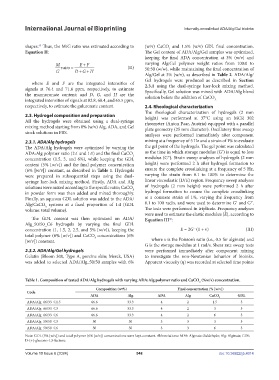Page 556 - IJB-10-6
P. 556
International Journal of Bioprinting Internally-crosslinked ADA/Alg/Gel bioinks
shapes. Thus, the M/G ratio was estimated according to (w/v) CaCO and 1.5% (w/v) GDL final concentration.
45
3
Equation II: The Gel content of ADA/Alg/Gel samples was optimized,
keeping the final ADA concentration at 3% (w/v) and
M EF+ varying Alg:Gel polymer weight ratios from 100:0 to
ratio = (II) 50:50 (w/w), while maintaining the final concentration of
G DG H+ +
Alg/Gel at 3% (w/v), as described in Table 2. ADA/Alg/
Gel hydrogels were produced as described in Section
where E and F are the integrated intensities of
signals at 76.4 and 71.6 ppm, respectively, to estimate 2.3.1 using the dual-syringe luer-lock mixing method.
Specifically, Gel solution was mixed with ADA/Alg blend
the mannuronate content; and D, G, and H are the solution before the addition of CaCO
integrated intensities of signals at 82.8, 68.4, and 65.5 ppm, 3.
respectively, to estimate the guluronate content. 2.4. Rheological characterization
The rheological characterization of hydrogels (2 mm
2.3. Hydrogel composition and preparation height) was performed at 37°C using an MCR 302
All the hydrogels were obtained using a dual-syringe rheometer (Anton Paar, Austria) equipped with a parallel
mixing method starting from 8% (w/v) Alg, ADA, and Gel plate geometry (25 mm diameter). Oscillatory time sweep
stock solutions in PBS. analyses were performed immediately after component
2.3.1. ADA/Alg hydrogels mixing at a frequency of 5 Hz and a strain of 1% to evaluate
The ADA/Alg hydrogels were optimized by varying the the gel point of the hydrogels. The gel point was calculated
ADA:Alg polymer ratio (2:1 and 1:1) and the final CaCO as the time in which storage modulus (G′) is equal to loss
3
concentration (1.5, 3, and 6%), while keeping the GDL modulus (G″). Strain sweep analyses of hydrogels (2 mm
content (5% [w/v]) and the final polymer concentration height) were performed 2 h after hydrogel formation to
(6% [w/v]) constant, as described in Table 1. Hydrogels ensure the complete crosslinking at a frequency of 5 Hz,
were prepared in subsequential steps using the dual- varying the strain from 0.1 to 100% to determine the
syringe luer-lock mixing method. Firstly, ADA and Alg linear viscoelastic (LVE) region. Frequency sweep analyses
solutions were mixed according to the specific ratio; CaCO of hydrogels (2 mm height) were performed 2 h after
3
in powder form was then added and mixed thoroughly. hydrogel formation to ensure the complete crosslinking
Finally, an aqueous GDL solution was added to the ADA/ at a constant strain of 1%, varying the frequency from
Alg/CaCO systems at a fixed proportion of 1:4 (GDL 0.1 to 100 rad/s, and were used to determine G′ and G″.
3
volume: total volume). The tests were performed in triplicate. Frequency analyses
were used to estimate the elastic modulus (E), according to
The GDL content was then optimized on ADA/ Equation III :
46
Alg_50/50_C6 hydrogels by varying the final GDL
concentration (1, 1.5, 2, 2.5, and 5% [w/v]), keeping the E = 2G . (1 + v) (III)
total polymer (6% [w/v]) and CaCO concentrations (6%
3
[w/v]) constant. where ν is the Poisson’s ratio (i.e., 0.5 for alginate) and
G is the storage modulus at 1 rad/s. Shear rate sweep tests
2.3.2. ADA/Alg/Gel hydrogels were performed immediately after component mixing
Gelatin (Bloom 300, Type A, porcine skin; Merck, USA) to investigate the non-Newtonian behavior of bioinks.
was added to selected ADA/Alg_50/50 samples with 6% Apparent viscosity (η) was recorded at selected time points
Table 1. Composition of tested ADA/Alg hydrogels with varying ADA:Alg polymer ratio and CaCO (%w/v) concentration.
3
Composition (wt%) Final concentration (% [w/v])
Code
ADA Alg ADA Alg CaCO 3 GDL
ADA/Alg_66/33_C1.5 66.6 33.3 4 2 1.5 5
ADA/Alg_66/33_C3 66.6 33.3 4 2 3 5
ADA/Alg_66/33_C6 66.6 33.3 4 2 6 5
ADA/Alg_50/50_C3 50 50 3 3 3 5
ADA/Alg_50/50_C6 50 50 3 3 6 5
Note: GDL (5% [w/v]) and total polymer (6% [w/v]) concentrations were kept constant. Abbreviations: ADA: Alginate dialdehyde; Alg: Alginate; GDL:
D-(+)-glucono-1,5-lactone.
Volume 10 Issue 6 (2024) 548 doi: 10.36922/ijb.4014

